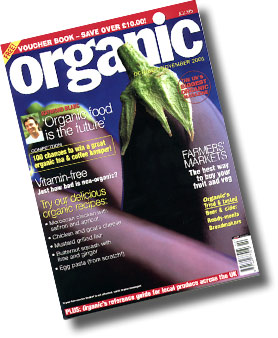


 GREEN FINGERS
GREEN FINGERSQuestion: What do you do if you cant find local organic food?
Answer: You grow it yourself.
Question: But what do you do if you haven't got much spare time and nowhere to grow the food?
Answer: You band together and share the space and the work.
And that's exactly what a group of people have done in West Bridgford, Nottingham.
Its a year since the Shared Garden Project was launched, and the families are preparing to turn their home-grown pumpkins into Halloween faces.
They can look back proudly on a truly bountiful harvest of beans, potatoes, cabbages, lettuces, tomatoes, onions, beetroot, garlic, cauliflowers, carrots , the list goes on and on to include various fruits, herbs and corns. You name it, they grow it!
Everything grown on the four allotments shared by the group is organic. And where possible the bio-dynamic growing method is used too. Its been such a success that the original membership of 12 has now expanded to 15. And it may even get bigger.
"This is an idea of its time," says Andy Thomas. "People want to have good food but they haven't got time to take an allotment on their own. This is a way of encouraging a number of people to produce the same result, but more joyfully."
The idea for the Shared Garden Project was dreamed up by Karina Wells and Andy Thomas, who both live in West Bridgford a suburb just a couple of miles out of the centre of Nottingham. Both have been involved with eco and organic activities for many years, both were allotment holders, and both were keen to share their allotment experiences with others.
"Sharing an allotment seems to be the answer for many busy people nowadays," explains Karina, who used to have a stressful job in the City and who then worked as a project co-ordinator for retailing chain Next. "There are many advantages, like the pleasure of working with a friend, sharing knowledge and skills, growing good quality organic produce, not to mention the more practical aspects such as running costs, dividing the work load and covering during the holiday periods. "And it was important to the group that their produce was grown organically.
"I don't trust the food available in the shops any more and there have been too many scares and too many blunders," says Karina. "The only way to combat it is to grow it yourself. I am concerned for my children and my childrens future, not just what they eat but all the pesticides and herbicides and GM foods and the effects it has on the environment, and I don't want to be part of it."
The team is a real mix of men and women, of novice-gardeners and experts, and of people with varying occupations.
Evelyn Wigmore and her daughter Katherine, three, meet Alison Goodchild and her three-year-old daughter Anna each week at the allotments. While the adults tend the plot, the children play quite happily.
"I like the companionship," says Evelyn, who's doing a floristy course. "You wouldn't really want to do two hours digging in your own garden, but if you do it here you can chat and you don't notice the time going by.
"I'm also learning how to grow vegetables, which I didn't know how to do before. The other thing I really like is that the children are involved. They have the freedom to run around, its all contained, and there are lots of things for them to play with. "And, of course, I also like all the fresh vegetables we have to eat."
Alison, who used to work in an art gallery before having her children, admits that she had no idea about vegetable growing until she joined the scheme. She would never have taken on a whole allotment herself. "Being able to benefit from the experience and the expertise of other people gives you confidence, and I feel I've learnt a lot," she says. "You only have to do two hours a week, which you can easily fit into your life-style. Its also been brilliant for the children to be out exercising in the fresh air and learning how things are grown."
Nursery nurse Jola Walker, who takes her three-year-old daughter Marie to the allotments, grew up in Poland where her family had a small farm. "It was my dream to have an allotment and then Karina came along with this scheme.." she says. "I cant think of a better place for Marie to play."
The Shared Garden Project has four allotments each is similar in size (about 500 sq yds) but very different from the other in terms of what is grown.
Allotment One was running fairly wild before the team began working on it. Nature had taken its course over 15 years, which produced great soil and, as a result, fantastic produce. Its been high-yielding from the start and the team has enjoyed everything from butter beans and beetroot to cucumbers and carrots. An experimental permaculture no-dig bed surrounded by a small woven bramble barrier has also been put down. "The idea is you never stand on it so it will never be compacted down and the worms can do their job without us disturbing them," explains Karina. "We put lots of manure on it and planted in it."
Group member Mary Ward is in charge of the bed, which contains perennial spinach and broccoli.
Allotment Two had been worked extensively before the team took it over, so it was decided to give it a rest. Much of it has been sown with rye and clover making it ideal for the children to play on. A climbing frame, easel and other toys have been put at one end near the shed, which acts as the communications centre for the group and houses a few indoor toys to keep the children entertained in bad weather.
Allotment Three was again planted with a variety of vegetables giving the group potatoes from June right through until the Autumn. Tomatoes, beetroot, carrots, onions, cabbages, leeks, parsnips, peas and beans are just some of the things that have been harvested over recent months. Its taken a lot of effort to get on top of the prolific bindweed on Allotment Four, which threatens to take a mile if given an inch! But peas, beans and more potatoes have all been grown on this allotment, which also houses a second experimental bed using layers of compost and layers of cardboard. Its here that the team has been growing pumpkins and squashes ready for Halloween and winter use.
One of the newest members is Caroline Hallam, an English teacher who loves to grow things but doesn't have a garden. "My daughter Holly loves growing things," explains Caroline. "We have a little yard and she loves planting but there's not much scope, so we decided to join. Its our chance to share a bit of a garden and grow things."
Freelance translator Monika Pepper enjoys the social side of the project as well as the fresh vegetables. "I didn't know anything about growing vegetables but I'm learning slowly," she says. "We couldn't have done this on an allotment on our own because the amount of work you have to do is phenomenal. But to get fresh vegetables for putting in two hours a week is good."
The Shared Garden Project has won a Millennium Award for its co-ordinator Karina Wells, who is now being sponsored to go on two courses and to write about the groups experiences. "We have a lot of data so we are hoping to pull it together during the winter months and I will write some sort of analysis on how to set up a project like this so other groups can do the same thing," she explains. "I would like to spread the word about what we have done, as a large number of people, probably about 60, are getting wholesome organic vegetables and a fantastic social life and other spin-offs. I would love this to happen in other places if I can help it."
How it works
Each member of the shared garden project pledges to spend two hours a week on the allotments. Initially, over the winter months, their work involved clearing the sites. But with so many people helping they soon moved on to sowing and transplanting.
A rota was drawn up and each person allocated a number of beds, with details of what needs doing and when. When it came to harvesting, members decided to take just enough for one day at a time. If there's suddenly a glut of something, Karina harvests, divides it up and contacts each member asking them to pop by and pick up some produce. "Its worked well so far," says Karina. "People have been a bit worried about taking things but while there's plenty and I supervise it to gauge whats available its been fine."
Communication is very important, so the group uses a diary and a board in the shed as its communication centre. "We also have a harvesting book where people write in what they have planted and what they have harvested," explains Karina. "At the end of the year we will have some sort of idea of what we got off it."
The cost of renting allotments varies from place to place, but those being worked by the Project cost an average of £21.50 a year each. At the beginning of the project each family contributed £20 as a start up cost to buy tools and seeds, plus a further £20 six months later. Its envisaged that in future years £20 from each will be enough to cover the costs.
Louise Duffield
mail@louiseduffield.co.uk
Published in:
Organics Magazine, October/November 2001. Reproduced here with permission of the publishers.
The original article included many specially commissioned photographs as well as details about bio-dynamic gardening, garden pests and garden tips.
Subscriptions to Organics Magazine, or back issues, can be obtained from:
wVIP
53-79 Highgate Road
London NW5 1TW
Phone 020 7331 1000
Fax 020 7331 1108
E-mail: organics@wvip.co.uk

| home | news | events | support | background | press |
| organic | bio-dynamic | recipes | books/links | images | members |
Visit our online shopping centre with over 150 retailers |
|||||